
The first session of the All-China National People’s Representatives’ Congress of the 12th convocation was held in March and determined the main directions of the state development of China as a powerful modern state - a regional and global leader. As part of the practical realization of the goals at the end of the last month of the current year, the first official visits of the new Head of China Xi Jingping were to the Russian Federation and the African region, particularly South Africa, where he took part in the BRICS summit.
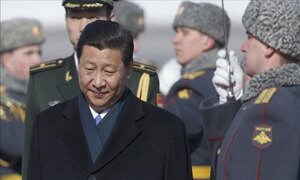 |
|
Jinping was met in Moscow with an official ceremony. After Russia Xi Jinping will visit Tanzania, South Africa, the Republic of Congo. Thus, as part of his first foreign tour, the new Head of China will visit three continents (including Asia, Europe and Africa) http://www.trtrussian.com/ |
Such visits indicate priorities of the foreign policy of China, and demonstrate orientation for further expansion of the PRC. So, judging by the content of the visits of Xi Jingping, the main goal is to strengthen China's positions in the developing countries (of the so-called "Third World"), in order to draw them into the orbit of the dominant influence of China in economic - and in the future – in political and security spheres.
The reason for this choice of Beijing is a high resource potential of the above-mentioned countries and regions (their having significant reserves of energy carriers, other minerals and agricultural land), and the availability of their economies to foreign interference due to the relative weakness and the need for loans and investments. Besides, China and the developing countries have a common interest in counter-acting the US influence both, all over the world, and in some regions, particularly Asia-Pacific, Central Asia, Africa and South America. At this, the PRC’s relations with countries of the "Third World" virtually exclude the factor of "human rights", which is critically important for Western partners of China.
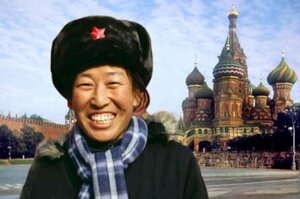 |
|
Chinese occupation of Russia- myth or reality? http://modernpolitics.ru/ |
In this context, the priority direction of the expansion of China is Russia, because of China’s great interest in access to natural resources in Eastern Siberia and the Far East (closest to Chinese consumers), an opportunity to get some modern technology (in the first place - the military), and accessibility for the Chinese demographic expansion.
Thus, within the framework of the so-called policy of "familiarization of northern territories," the PRC specifically encourages the relocation of "extra population" to other countries, primarily to the Russian Federation. According to various estimates, today the total number of Chinese citizens residing in the territory of Russia (both legally and illegally), makes almost 5 million people. The Chinese Diaspora in Russia has already established stable centers, allowing to accept and adapt a virtually unlimited number of their fellow tribesmen. Actually this potential consists of 150 million Chinese citizens (more than Russia's total population) who are unemployed and must seek work outside their country.
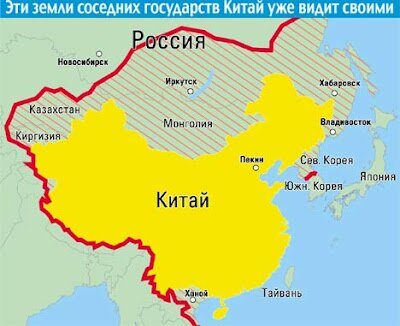
|
|
The map, which was noticed by Russian officers at the joint trainings of Russia and China in 2005 http://forum-pmr.net/ |
Demographic expansion of China in the Russian direction is carried out through joint economic and investment projects. In particular, today, Chinese investments into the development of Russian regions have already exceeded 5 billion US dollars, which is almost three times more than Russia’s own targeted investments. Besides, China is investing into other industries and the Russian banking sector, which makes about 90-100 billion US dollars (almost a quarter of the state budget of the Russian Federation).
Due to this, China already has real levers of influence on domestic and foreign policy of Russia, and an access to Russian natural resources. In fact, Moscow has no control over the relocation of Chinese citizens to the territory of Russia and realization of potential territorial claims against Russia. In recent years, under the relevant agreements with Russia, China has gained control of the nearby districts along the banks of the Amur River and still claims to more than one million square kilometers of Russian territories.
The visit of the Head of China Xi Jingping to Russia which took place on the 22-24th of March this year will help the Chinese to reach the desired in the future. Following the talks with the leadership of Russia, there were signed a number of documents in the economic (energy), financial and military-technical spheres, including an agreement between Russian companies "Uralvagonzavod" and "VTB-Leasing" and the Chinese group "Honghua" on the production of heavy drilling rigs, a framework Agreement on cooperation between the Russian "Synthesis Group" and State Electric Network Corporation of China, as well as an agreement between Russia's En + Group and a Chinese Corporation of Foreign Development and Investment "Shenhua" and the State Development Bank of China on cooperation in the development of coal resources.
Has been signed also a number of financial transactions on the cooperation between the Corporation "Metals of Eastern Siberia" and the State Development Bank of China, “Rosgosstrah” and China's international investment company
“Chentun” and the Russian bank VTB and the Construction Bank of China.
|
Company "HunHua Group" is a part of the Stock Exchange Union of Hong Kong, and is one of the largest manufacturers and suppliers of oil drilling land drilling rig in the world. The Company "Hun Hua Group" can produce up to 150 oil drilling rigs a year, besides, in America, in Russia, UAE, Ukraine and Egypt there were opened joint or daughter companies. Honghua, India, Pakistan, Uzbekistan opened offices "HunHua" representation International ShenHua Company is a representative of the China ShenHua Energy Company Corporation - the largest coal producer in mainland China, one of the largest coal mining companies on the planet, the largest, by capitalization, producer of coal in the world. http://rabota.mail.ru/employer/927736 Group of companies "Chentun" was founded in 1992. At the moment the holding is represented by many enterprises stock exchanges of China in Shanghai, Hong Kong and Shenchzhen. This company «Chzhunchu" (600,787), Inc. "Yuehuabao" (200986) "Chentun fachzhan" (00217), Inc. "Huanhao" (600,433) and the company for the production of paper "Yueyan" (600,963). In Hong Kong "Chentun" owns international business-grounds. http://www.greenwoodpark.ru/about/invest/ |
A major achievement of China in the military-technical sphere can be considered signing of the framework agreement with Russia for the supply of the Chinese side with Su-35 and diesel submarines of Russian make. Experts estimate that in the future the parties may extend the military-technical cooperation (MTC) and China will get Russian Anti-Aircraft Missile systems S-400, military transport aircrafts Il-76 and tanker aircrafts IL-78.
As to the participation of Xi Jinping in the BRICS summit, it indicates the increased attention of China to regions of Africa and Latin America, which more and more resemble an arena of struggle for influence between China and the United States.
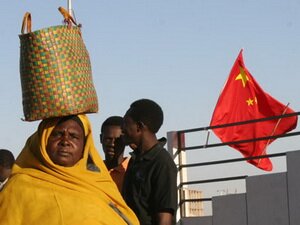 |
|
Over the past 20 years, China has come a long way to come to the African continent http://asiareport.ru/ |
Thus, beginning from 2009, China is the largest investor and trading partner of the countries of the African region. Like in other regions with transition economies, the main interests of China in Africa are to get access to energy and other natural resources, as well as to agricultural land. For example, in 2012 China's total trade volume with African countries made about 300 billion US dollars. The main partners of China are South African Republic (ranked first in the trade balance with China, among other countries of Africa, in 2012 China's exports to South Africa made 112 billion US dollars, and imports - 90 billion US dollars), Sudan (provides 5 % of oil imports to China), Nigeria, the Democratic Republic of Congo, Angola, Tanzania and Ethiopia.
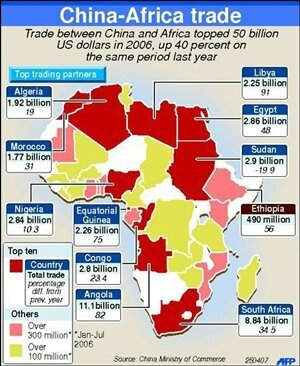 |
|
Recently China began to penetrate into Africa, trying to take over whole segments of European TNC businesses http://hvylya.org/ |
Relations between China and African countries are developing both, on a bilateral basis, and within the framework of the China-Africa Forum, covering Chinese partners in the region. Over the next two years, China will invest into the development of the economy of the region more than 20 billion US dollars.
Xi Jingping confirmed such plans of China during his visit to Africa on the 25-28th of March. For example, as a result of his talks with the leadership of Tanzania, were signed 17 agreements in the field of trade, investment, infrastructure construction, agriculture, communications and processing industry. The main result of the visit of Xi Jinping to the Republic of Congo became agreements on Chinese participation in energy projects in Kazakhstan, and on Congolese energy supplies to China.
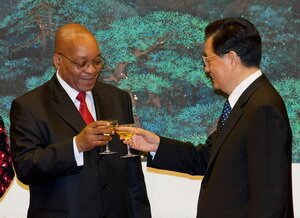 |
|
Meeting of the South African President Jacob Zuma with the Chinese President Hu Jintao in Beijing. Photo: Reuters http://russiancouncil.ru/ |
A large number of bilateral agreements and arrangements in the trade and economic cooperation was also signed between China and the Republic of South Africa. The two leaders even agreed to hold in 2015 the "Year of China" in South Africa.
China is actively strengthening its positions in Latin America, which more and more resembles an arena where China, the USA and the European Union struggle for their influence. At this, a more dynamic development of China is gradually changing the balance of forces exactly in its favor. Thus, experts are of the opinion that by 2015, China could overtake the EU and become the second largest investor in the region after the United States.
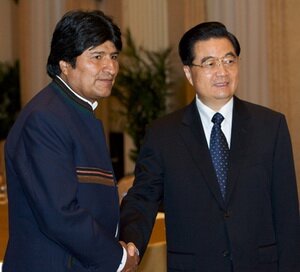 |
|
Bolivian President Evo Morales and Chinese President Hu Jintao Фото: Синьхуа http://www.tsenki.com/ |
Today, China is the largest trading partner of Brazil, Chile and Peru, and is the second largest in terms of volume of trade with Argentina, Cuba, Costa Rica and Venezuela. According to the Ministry of Trade of China, the total amount of Chinese investments in the Latin American economy is more than 245 billion US dollars. This was one of the main reasons having allowed Latin America comparatively easily to overcome negative effects of the global financial and economic crisis, which led to a decrease of trade with the USA and EU countries in the region by about 30%. But China's trade with the region, on the contrary, has increased.
It is clear that the authority of China in Latin America is growing. According to sociological research, about 70% of the population perceives China positively, while 20% believe China is the most influential country in the world.
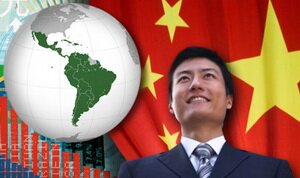 |
|
China has become one of the greatest investors into the economy of countries of Latin America and Caribbean region |
The main efforts in Latin America today China is making for further penetration of Chinese businesses into the region's economy, as well as overcoming the resistance to Chinese influence from Brazil, Mexico and Argentina. Here China opposes to its competitors wide opportunities to saturate the market with cheaper goods and providing virtually unlimited loans and investments on favorable terms.
China has its own priorities also in the Asia-Pacific region, South-East and Central Asia and in the Middle East. For example, China is the largest investor in the countries there. The main Chinese partners are South Korea, India, Thailand, Indonesia, Laos, Myanmar, Cambodia and Vietnam.
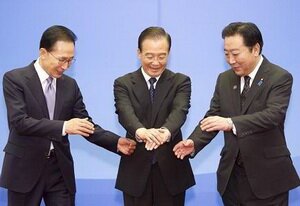 |
|
China, Japan and South Korea agreed to begin talks on creation of the free trade area http://zn.ua/ |
Thus, in 2012 the volume of trade between China and South Korea grew to more than 200 billion US dollars. In the coming years, this figure is planned to increase to 300 billion US dollars.
Dynamic and positive are also economic and trade relations between China and India, despite the fact that there are serious problems in their relationship. If China's exports to India remain stable, by 2015 the volume of the trade between the two countries will make 100 billion US dollars.
Central Asia is fundamentally important for China, because, like Russia, it directly borders with China. China's interests in the region include energy, mining industries (primarily radioactive and rare earth metals), agriculture and infrastructure.

|
|
Kazakhstan and China have discussed the questions of the bilateral cooperation http://www.trend.az/regions |
The main partner of China in Central Asia is Kazakhstan. The total Chinese investment in Kazakhstan's economy is more than 15 billion US dollars, higher than the investment of all other countries, including Russia. The most ambitious joint projects are the development of oil fields in Aktobe, Atyrau, Mangistaursky, Kyzylorda and Karaganda regions of Kazakhstan and the Kazakh Caspian Sea, as well as the construction of the oil pipeline infrastructure from Kazakhstan to China.
In Kyrgyzstan, China is financing the construction of an electric power line, which will close in the country's energy ring (total investment of around 500 million US dollars), the construction of an oil refinery near the city of Bishkek (250 million US dollars) and the road China - Kyrgyzstan - Uzbekistan (up to 2 billion US dollars), and the development of gold deposits in the Chon-Alai region of the country (more than 20 million US dollars).
China is the main financial donor to Tajikistan. In recent years, China has provided more than 1 billion US dollars of preferential loans and loans for the construction of roads, bridges and electric power lines. With China's help, is being constructed the first steel plant in the Republic (the amount of Chinese investments is 120 million US dollars), a hydro-electric power station "Nurabad-1" on the river Khingob with the capacity of 350 MW (cost is 650 million US dollars), a coal thermal electric power station in Dushanbe (400 million US dollars), and are being upgraded the power lines "North-South" and "Lozazor-Khatlon" (61 million US dollars). The share of China is about 40% of Tajikistan's foreign debt. In exchange for the investments, Tajik authorities have granted China the right to extract gold, uranium and other rare metals, and gave away to China about 1 thousand kilometers of the disputable territories.
An important partner of China in Central Asia is Turkmenistan, trying to diversify its trade and economic relations with Russia and other countries. In recent years, the main joint project of Turkmenistan and China was the construction of the Turkmenistan – China gas pipeline. Within the framework of the project, China won the right to develop oil and gas fields in Turkmenistan. The total investment of the PRC into the Turkmen economy is more than 8 billion US dollars, far exceeding the relevant investment indexes of the Russian Federation.
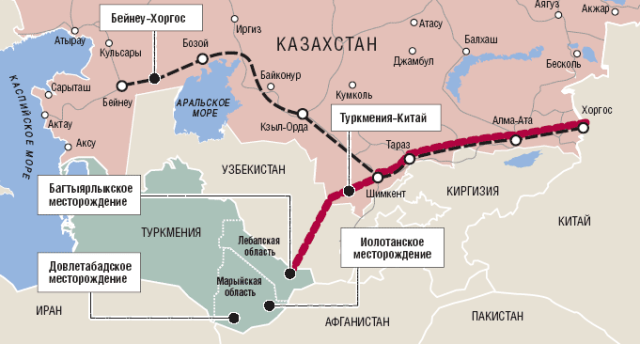
|
| Turkmenistan-Uzbekistan-Kazakhstan-China gas pipeline http://www.opec.ru/ |
Relations between China and Uzbekistan develop in a similar way. Total Chinese investments into the Uzbek economy make about 6 billion US dollars, which are mainly used to implement joint economic projects in the energy sector. The Uzbek branch of the gas pipeline is being constructed to China (cost up to 2.2 billion US dollars), and are being realized joint programs in the spheres of transport, chemical industry and geological exploration of uranium deposits.
Taking into consideration the determination of foreign policy of China, we can assume also China's becoming more active in other regions with economies in transition, in particular in the Central-Eastern and South-Eastern Europe, including Ukraine.

|
|
Great Chinese resettlement http://demoscope.ru/ |
At the same time, China is also developing partnership with leading developed countries, which are major consumers of Chinese products. First of all, the USA, EU countries and Japan, occupying leading positions in the foreign trade of China. In 2012, the volume of trade of China with the USA reached 490 billion US dollars, with the EU - 550 billion US dollars and with Japan - 330 billion US dollars.
However, unlike developing countries, and countries that are gradually becoming (openly or not) satellites of China, leading states of the world still have equal positions with China in today's multi-polar world.








